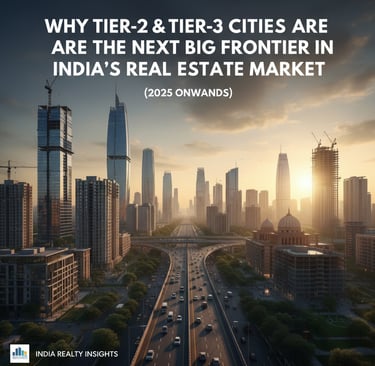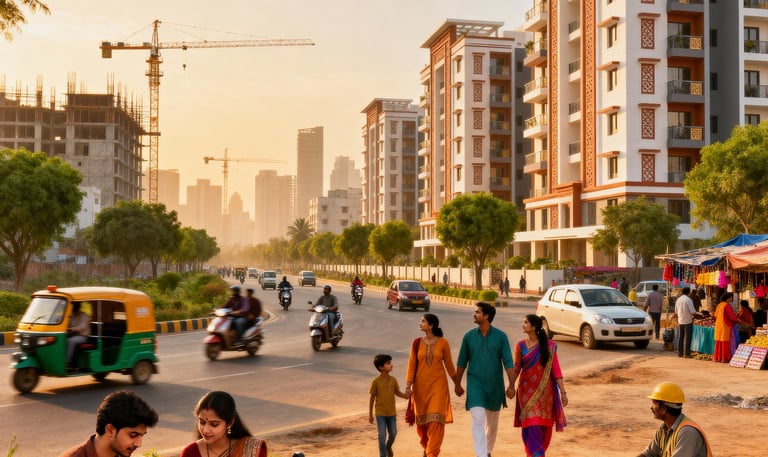Why Tier-2 & Tier-3 Cities Are the Next Big Frontier in India’s Real Estate Market
For decades, India’s real estate story was written by the big metros—Mumbai, Delhi, Bengaluru, and Hyderabad. But as we step into 2025, the spotlight is shifting toward Tier-2 and Tier-3 cities. With improved infrastructure, rising employment opportunities, and government initiatives boosting region
flixahdevelopers
11/10/20255 min read


Why Tier-2 & Tier-3 Cities Are the Next Big Frontier in India’s Real Estate Market (2025 Onwards)
For decades, India’s real estate story was written by the big metros—Mumbai, Delhi, Bengaluru, and Hyderabad. But as we step into 2025, the spotlight is shifting toward Tier-2 and Tier-3 cities. With improved infrastructure, rising employment opportunities, and government initiatives boosting regional growth, these smaller cities are fast becoming the next big investment destinations in Indian real estate.
1. The Changing Face of Indian Real Estate
India’s real estate market is evolving rapidly. The rising cost of living and skyrocketing property prices in metros have pushed both homebuyers and investors to explore smaller, more affordable cities.
According to industry reports, nearly 40% of new housing demand in 2025 is expected to come from Tier-2 cities such as Indore, Nagpur, Coimbatore, Surat, and Vizag, among others. Tier-3 towns like Warangal, Mysuru, and Madurai are also catching up, supported by strong infrastructure and industrial development.
The Indian government’s Smart Cities Mission, AMRUT, and PM Awas Yojana have accelerated urbanization in these regions, turning once-sleepy towns into thriving real estate hubs.
2. Why Tier-2 and Tier-3 Cities Are Becoming Attractive
a) Affordable Property Prices
The biggest driver is affordability. While property prices in metros often exceed ₹10,000 per sq. ft, you can still find prime plots and apartments in Tier-2 cities for as low as ₹3,000–₹5,000 per sq. ft.
This price gap not only makes homeownership more achievable for the middle class but also attracts investors looking for higher appreciation potential over time.
b) Improved Connectivity and Infrastructure
Infrastructure development is transforming smaller cities. New highways, airports, and railway projects are connecting Tier-2/3 cities to major industrial and IT hubs.
For instance, projects like the Delhi-Mumbai Industrial Corridor (DMIC) and Chennai-Bengaluru Industrial Corridor are driving both residential and commercial growth in nearby towns.
c) Rise of Remote Work and Quality of Life
Post-pandemic work trends have permanently changed the real estate map. Many professionals now prefer to work remotely from smaller cities where they can enjoy a better quality of life, cleaner environments, and lower costs.
This has created new demand for premium housing in these towns—something unheard of just a few years ago.
d) Expanding Job Opportunities
With major companies opening regional offices and new industrial parks coming up, Tier-2 cities are no longer just retirement or hometown destinations—they are employment hubs.
Cities like Pune, Chandigarh, Coimbatore, and Jaipur are seeing a surge in IT, education, healthcare, and manufacturing sectors, driving steady housing demand.
3. Investment Potential: Early Movers Will Benefit
Every major real estate boom begins with early adopters. Investors who entered Bengaluru and Pune in the early 2000s reaped massive rewards as these cities grew.
Now, the same story is unfolding in Tier-2 and Tier-3 cities.
If you invest early—before mass migration and infrastructure saturation—your property’s appreciation potential is much higher. Land parcels near expanding industrial zones or future transport corridors can deliver returns of 50–100% in just a few years, depending on location and development pace.
Moreover, rental yields in smaller cities are improving, offering a dual benefit of steady income and long-term appreciation.
4. Real Estate Trends Driving This Shift
Affordable Housing Demand: The government’s push for affordable homes and easier home loan access has boosted demand outside metros.
Rise of Co-Living and Senior-Living Projects: Developers are diversifying their projects in Tier-2 cities to cater to young professionals and senior citizens.
Local Developer Partnerships: Many big builders are joining hands with trusted local developers to launch projects in smaller towns.
Digital Real Estate Growth: Online property portals and digital marketing have made it easier for buyers to discover investment opportunities across India.
5. What to Check Before Investing in a Tier-2 or Tier-3 City
Investing in emerging markets offers great potential, but it also requires caution. Here are some key factors to evaluate before purchasing property:
Location Connectivity: Check proximity to highways, airports, industrial parks, or IT zones.
Upcoming Infrastructure Projects: Roads, metro lines, and government development plans can significantly impact property value.
Builder Reputation: Partner with developers who have a transparent record and proper approvals.
Legal Verification: Ensure clear title deeds, RERA registration, and land conversion approvals.
Future Growth Potential: Look for cities with rising population, job creation, and steady demand.
6. Emerging Real Estate Hotspots in 2025
Indore (Madhya Pradesh): A fast-growing IT and education hub with strong infrastructure.
Surat (Gujarat): The diamond and textile capital is expanding into residential and commercial real estate.
Coimbatore (Tamil Nadu): An industrial city with good connectivity to Chennai and Bengaluru.
Nagpur (Maharashtra): Strategically located in central India, now a major logistics hub.
Vizag (Andhra Pradesh): Gaining importance due to industrial corridors and port connectivity.
These cities combine affordability, infrastructure, and growth—key ingredients for sustainable real estate appreciation.
7. The Role of Developers and Advisors
Navigating real estate in smaller cities can be complex due to varying regulations and local market dynamics. That’s where the role of professional developers and property consultants becomes essential.
Expert developers understand where growth is moving next, how to evaluate land legally and technically, and which projects offer long-term returns. Their insights help investors avoid costly mistakes and focus on value-driven opportunities.
8. The Future of India’s Real Estate Lies Beyond Metros
The real estate boom of the next decade won’t just happen in big cities—it will spread to every corner of India where infrastructure meets opportunity.
As India urbanizes and incomes rise, the next wave of prosperity will emerge from its smaller cities—creating wealth, homes, and employment for millions.
For investors and buyers alike, the time to act is now. Waiting until these cities become fully developed may mean missing out on the highest growth phase.
How Flixah Developers Pvt. Ltd. Helps You Make the Right Property Choice
At Flixah Developers Pvt. Ltd., we understand that choosing the right land or property is more than just a purchase—it’s a foundation for your future wealth.
Our team specializes in helping buyers and investors identify high-growth locations across India’s emerging real estate markets. Whether you’re looking for a residential plot, commercial property, or long-term investment land, we provide data-driven insights, legal verification, and transparent guidance.
By working closely with clients, Flixah Developers ensures that every property selected aligns with your budget, lifestyle, and long-term financial goals. With our expert support, you can confidently invest in the right property today for a secure and profitable tomorrow.
for more info on real estate market please visit our website flixahdeveloperspvtltd.com and you can also reach us at +91 9100600730






